Sound bites instead of answers?
By Ashahed M. Muhammad -Assistant Editor- | Last updated: Nov 4, 2015 - 1:05:04 PMWhat's your opinion on this article?
U.S. criminal justice system, policing strategies and tactics blasted by activists as law enforcement officials spew rhetoric instead of reforms
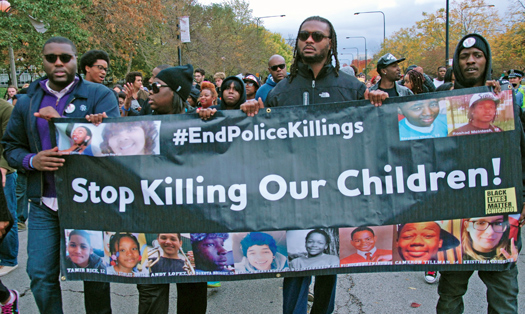
Activists called for reform and an end to police brutality during protests like the one held in Chicago recently.
|
CHICAGO (FinalCall.com) - Viral videos and public outcry have altered police behavior, claim some media outlets, political leaders and law enforcement officials. Officers are more conscious of behavior and professionalism, say some. Others claim officers are scared to do their jobs due to a “Ferguson Effect,” scrutiny of police behavior during and after the uprising in the St. Louis suburb.
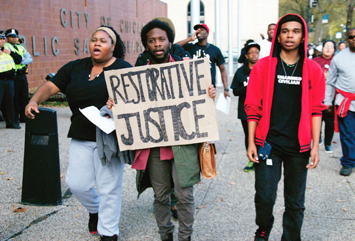
Activists called for criminal justice reform and an end to the prison industrial complex.
|
Officers’ fears are leading to an increase in crime as cell phones appear at almost any encounter and cops don’t want to get into trouble, they argue.
Activists say talk of a “Ferguson Effect” and charges that the Black Lives Matter movement is violent and virulently anti-police is just another attempt to avoid accountability. Meanwhile, they add, rhetoric aimed at stoking the anger of officers and directing that anger at anti-police brutality activists is on the rise.
Media outlets and internet sites popular with right-wingers have lead with talk that Black Lives Matter is a terrorist group. Fox Network stars Bill O’Reilly and Sean Hannity, on numerous occasions, have compared Black Lives Matter to the Ku Klux Klan. Milwaukee County Sheriff David A. Clarke Jr. recently tweeted to 96,400 followers a warning that Black Lives Matter activists will become allies of Islamic State militants battling for control of parts of Iraq and Syria.
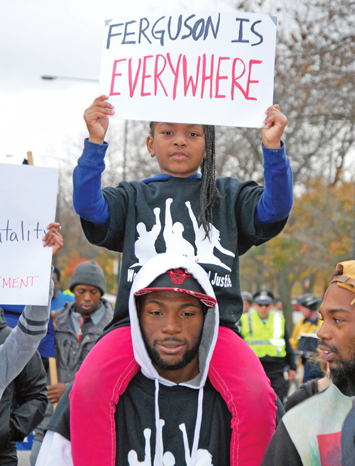
A young girl holds up a sign at a recent anti-police brutality protest held in Chicago. Photos: Haroon Rajaee
|
“Before long, Black Lies [sic] Matter will join forces with ISIS to [bring] down our legal constituted republic. You heard it first here,” he wrote.
The rhetoric is reminiscent of language used to demonize and vilify #OccupyWallStreet activists, Black power advocates, and anyone who wishes to challenge the status quo set, activists and youth leaders said.
President Barack Obama addressed the International Association of Chiefs of Police Oct. 27 to wrap up its 122nd Annual Conference, which began here Oct. 24. During brief comments, he tried to walk the line between placating law enforcement and acknowledging complaints of those who see Black and Latino youth being criminalized. More than 14,000 public safety professionals attended the conference.
“I reject any narrative that seeks to divide police and communities that they serve. I reject a storyline that says when it comes to public safety there’s an ‘us’ and a ‘them’—a narrative that too often gets served up to us by news stations seeking ratings, or tweets seeking retweets, or political candidates seeking some attention,” President Obama continued. “Your work and your service really has helped make America safer than it’s been in decades, and that’s something for which every American should be proud,” he added.

Activists called for criminal justice reform and an end to the prison industrial complex.
|
“In fact, 2013 saw the fewest cops shot and killed in the line of duty since 1887,” said President Obama.
Although he finds the spike in violent crime “real and deeply troubling” in “predominantly urban, minority communities,” the president called on law enforcement officials to work to combat increased criminal activity.
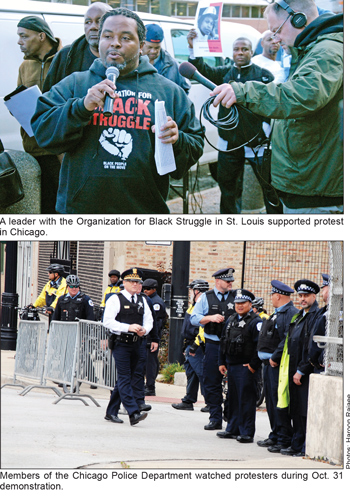
|
The president recommended using some of the $80 billion spent annually on prisons to increase funding for mental health treatment, drug treatment, and new ways of rehabilitating non-violent offenders. While he mentioned surveillance cameras trained on Chicago hot spots, noticeably absent were any references to body-cameras for police officers.
President Obama added, “As I said in my State of the Union address this year, I am convinced that progress comes together when we work together, and we work together best when we’re willing to understand one another—when, instead of having debates over talk radio, we stop and listen to each other so that we can empathize with the father who fears his son can’t walk home without being mistaken for a criminal; and when we sympathize with the wife who can’t rest until her husband walks through the front door at the end of his shift.”
While the reference to rehabilitation programs was notable, absent was any call for reformation and regulation of the bail bond industry and process. Many poor non-violent offenders languish in jail until trial because they cannot afford bond.
While activists have effectively used the hashtag #BlackLivesMatter to call attention to police violence under the color of law, police responded with #BlueLivesMatter and #PoliceLivesMatter to counter the issues raised by activists.
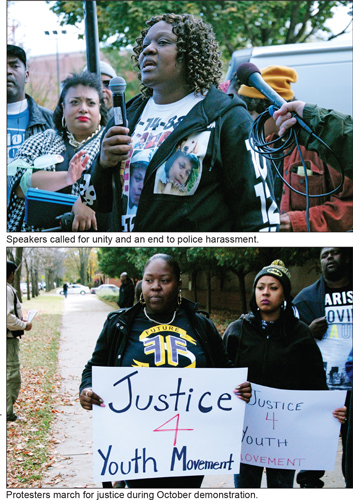
|
Ironically FBI Director James Comey’s remarks at IACP 2015 could have been interpreted as more sympathetic to the Black Lives Matter movement, the effects of mass incarceration in the Black community, drug addiction and the role of the drug trade in crime.
“Yes it is true that young men of color have long been dramatically overrepresented among both homicide victims and killers, but it is also true that White people buy the overwhelming majority of the drugs in America and that White people’s demand for drugs drives the trade, and that is a problem that this country cannot continue to drive around,” Mr. Comey told the gathering of law enforcement officials.
“There is a line of law enforcement and a line of communities we serve, especially of communities of color in the hardest hit neighborhoods in this great country of ours, and I actually feel those two lines arcing apart,” said Mr. Comey. “Each time somebody interprets hashtag Black Lives Matter as anti-law enforcement, one line moves away. And each time someone interprets hashtag ‘police lives matter’ as anti-Black the other line moves away.”
Mr. Comey, however, did not address why members of the FBI Joint Terrorism Task Force tracked Black Lives Matter members and their protest in December 2014 at the Mall of America in Bloomington, Minn., nor did he address militarized responses to protests in New York, Ferguson, Mo., and Oakland.
Documents obtained by CNN revealed a Missouri National Guardsman used the term “enemy forces” and “adversaries” to describe Ferguson protestors exercising their rights to free speech and free assembly.
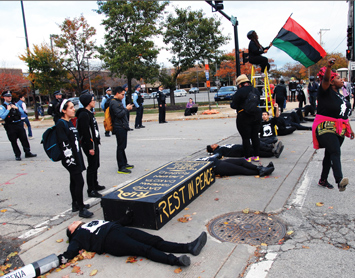
|
A counter-conference by grassroots youth, racial and social justice activist organizations started Oct. 22. Called “I Shocked the Sheriff,” participants at the counter-conference demanded that IACP end criminalization of Black and Latino communities across the country, increase police accountability though more community control and involvement, and end the so-called “War on Drugs.”
The Black Youth Project 100 is a national organization of activists between the ages of 18 to 35 involved in the #BlackLivesMatter movement.
Camesha Jones, communications co-director of the Black Youth Project 100’s Chicago chapter, said police have a responsibility to those they are paid to serve.
“Their duty is to protect and serve regardless to what pressures are going on in the outside world and they’re supposed to be keeping us safe and not harming us,” she said.
Many complained that as police departments promised or examined citizen review boards to look into charges of excessive force and unlawful use of deadly force, so-called reform efforts have not gone far enough. President Obama’s tepid calls for reform are really “too little, too late,” according to activists.
“I think that many people would have liked Barack Obama to do some of the things that he’s doing now earlier, but we’re here now, and this is what’s happening,” said Ms. Jones. “I think it is great that he’s interested in criminal justice reform because no other president has taken that under their wing. I don’t know if he’ll have enough time to really address the things that he wants to do, and again, I think a lot of people wished it would have happened sooner but I’m at least happy that he’s doing something right now,” she added.
Many remain critical of the federal government’s 1033 Program. The program, created by the National Defense Authorization Act of Fiscal Year 1997 as part of the U.S. Government’s Defense Logistics Agency Disposition Services, allows the transfer of military grade equipment to police departments.
Such equipment includes Mine Resistant Ambush Protected (MRAP) armored vehicles, night vision goggles, scopes and binoculars, infrared gun sights, aircraft, high-powered machine guns (such as M-14s and M-16s) and high capacity magazines, grenade launchers and other lethal tactical weapons.
Eight thousand local law enforcement agencies in all 50 states were eligible to receive stockpiled military hardware.
Devices that send messages and high decibel warning tones—called Long Range Acoustic Devices—are also possessed by many police departments. Stingrays, also known as “cell site simulators,” are surveillance devices that mimic cell phone towers by sending out signals “tricking” cell phones into transmitting their location and identifying information.
Fifty-seven agencies in 22 states and the District of Columbia possess stingray equipment and technology, according to the American Civil Liberties Union.
“Weapons of war belong on the battlefield, not on the streets,” said Teresa Smallwood of the Workers Center for Racial Justice.
In a joint statement several groups, Assata’s Daughters, We Charge Genocide, and #Not1More, joined BYP 100 in challenging militarized police forces operating in civilian zones.
“The global nature of the IACP conference is not lost on us. We know that American police officers train with defense agents occupying other lands where Black Palestinians and African migrants experience double oppression. State violence is connected not just from local police station to police station, but also globally among various occupying forces,” the statement said.
“Black people deserve to live with human dignity. We are building a movement rooted in people who understand why we must fight. We are constantly at risk of experiencing anti-Black violence by state and its accomplices. Today, we are putting ourselves at risk to take power over our futures because we know that our liberation will not be handed to us, we have to build it ourselves.”
“The statistics tell a story we’re all too familiar with: Youth of color are being criminalized on the street and in the classroom—sometimes brutally,” said Anthony Romero, executive director of the American Civil Liberties Union, in a statement emailed to The Final Call.
“Criminalizing students for minor misconduct just marginalizes the students who most need help and funnels them into the school-to-prison pipeline. Treating our young people like criminals is traumatizing for them, and destructive for our society as a whole,” he added.
Activists said unwarranted and excessive brutality against Black youth is commonplace and has deep roots—whether it is the legacy of the police commander Jon Burge’s era of torture in Chicago or charges a “black site” used for off the books interrogations in Homan Square in the city.
It is seen in the widely seen video of a high school girl slammed to the floor by a police officer, who has been fired, in Columbia, S.C.
According to human rights activists, a policy of torture and immediate use of lethal force implemented at the highest levels of the nation’s government gives license to lower levels of law enforcement to implement those same types of procedures.
The ACLU is filing a case on behalf of three torture victims who suffered during the CIA torture program of the Bush administration. The suit is aimed at two psychologists who designed and ran the program.
INSIDE STORIES AND REVIEWS
-
-
About Harriett ... and the Negro Hollywood Road Show
By Rabiah Muhammad, Guest Columnist » Full Story -
Skepticism greets Jay-Z, NFL talk of inspiring change
By Bryan 18X Crawford and Richard B. Muhammad The Final Call Newspaper @TheFinalCall » Full Story -
The painful problem of Black girls and suicide
By Charlene Muhammad -National Correspondent- » Full Story -
Exploitation of Innocence - Report: Perceptions, policies hurting Black girls
By Charlene Muhammad -National Correspondent- » Full Story -
Big Ballin: Big ideas fuel a father’s Big Baller Brand and brash business sense
By Bryan Crawford -Contributing Writer- » Full Story






 Click Here Stay Connected!
Click Here Stay Connected!








